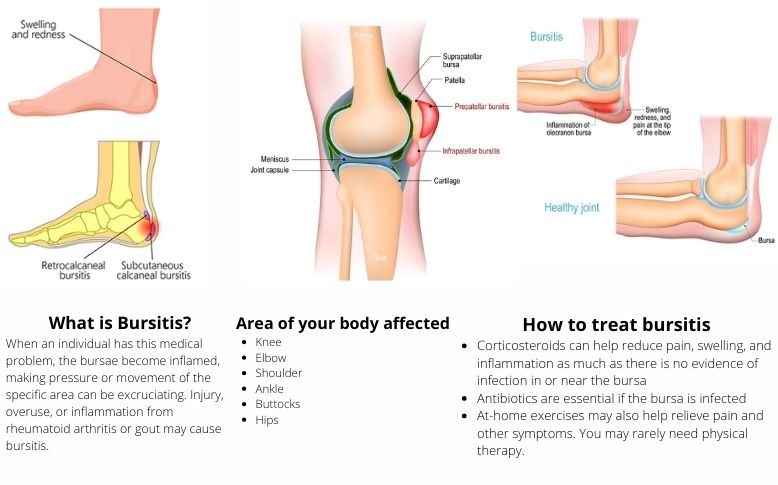What is Bursitis?
Bursitis is a painful medical condition that affects your joints. Bursitis can limit the ways you can move your joints. It occurs when bursae, fluid-filled sacs, become inflamed. Bursae acts as a cushion and lubricate points between tendons, bones, and muscles. And there are more than 150 bursae in our bodies.
Bursae surround the areas where skin, tendons, and muscle tissues meet bones. The lubrication they add to the bones helps reduce friction during the movement of the joint. Bursitis is an inflammation of your bursae, and inflamed bursae cause pain and severe discomfort in the affected location. When an individual has this medical problem, the bursae become inflamed, making pressure or movement of the specific area can be excruciating. Injury, overuse, or inflammation from rheumatoid arthritis or gout may cause bursitis.
What causes Bursitis?
Bursitis can happen from an infection, an injury, or a pre-existing condition such as gout, which can form crystals to form in a bursa.
Injury
Physical trauma may irritate the tissue inside the bursa and cause inflammation. This trauma is more likely to occur because of an impact injury or overuse of the tendons, joints, or muscles near the bursa. Overuse is usually the result of repetitive joint movementṣ.
The cause of this medical condition can determine the area of your body affected. Some possible reasons are:
- Knee: Repeated, continuous kneeling can cause injury and swelling of the bursae in the knee area.
- Elbow: Repetitive elbow bending can cause damage and inflammation. Hence this condition is a problem among golfers and tennis players.
- Shoulder: Repetitive overhead lifting or reaching heights can cause shoulder bursitis
- Ankle: Injury of the ankle can happen if walking excessively and with the wrong shoes.
- Buttocks: The bursae near the lower pelvis can inflame after sitting on a hard surface for a prolonged time, such as on a bicycle. Here, an individual may notice discomfort in both buttocks and legs.
- Hips: Hip bursitis can occur due to excessive stair climbing, running, or standing for an extended time.
Infection
Infectious bursitis usually occurs in the bursae near the skin surface, such as the elbow. A skin cut is an opportunity for the bacteria to strike in. As with other bursitis forms, repetitive trauma and overuse of joints close to bursae are the common causes of any infectious bursitis. People with health conditions concerning the immune system may have a higher risk of developing bursitis due to an infection.
Health conditions
People with specific medical conditions are more likely to form crystals inside the bursa. The crystals make the bursa swell by irritating it. Some situations that may cause bursitis include rheumatoid arthritis, gout, and scleroderma.
What is Bursitis of the hip?
- Bursitis of the hip, also known as Trochanteric bursitis, is a painful condition with swelling and causes joint pain and tenderness. Under this condition, one may feel the warmth and spray close to the affected area.
- Often, the pain is sharp, usually in the first few days, may get dull and achy later. You may experience it more while getting up from the chair or bed or sitting for a prolonged duration and sleeping on the affected side.
- Several things cause hip bursitides, such as rheumatoid arthritis, repeated overuse or stress of the hip, gout (or pseudogout), injury of the hip, diabetes, uneven leg lengths, infection with bacteria (staphylococcus aureus or staph infection), spine problems (such as scoliosis), or bone spurs (growth of a new bone on top of a normal bone) on the hip.
How to heal hip bursitis quickly?
- Hip bursitis treatment usually involves stretching and strengthening exercises as it helps prevent muscle atrophy. Ask your medical healthcare provider about activities that can quickly help build strength in the area.
- Your hip bursitis can affect your ability to function normally; in that case, you may need effective physical therapy to move again. Inability to function comes typically, especially when you have chronic bursitis.
- To get quick relief, you can also use nonsteroidal anti-inflammatory drugs, including ibuprofen (also comes as brand names: Advil, Motrin) or naproxen (also known as Aleve) to relieve pain and swelling.
How to treat bursitis in the shoulder?
Pain medication, rest, and icing the joint may help relieve your bursitis. However, other treatment measures may be necessary:
- Corticosteroids can help reduce pain, swelling, and inflammation as much as there is no evidence of infection in or near the bursa
- Antibiotics are essential if the bursa is infected
- At-home exercises may also help relieve pain and other symptoms. You may rarely need physical therapy.
How long does bursitis last?
Bursitis can last from a few days to a few weeks. One can treat the condition at home and make it go away in a few weeks. Bursitis is more likely to improve within a few days or weeks if you take proper rest and treat the affected area. But it may come back if you do not stretch and strengthen the muscles near the joint and change some activities.

